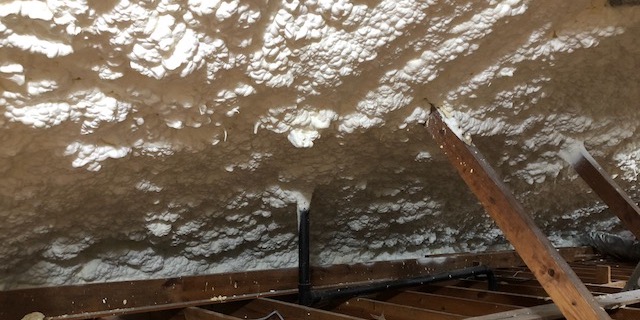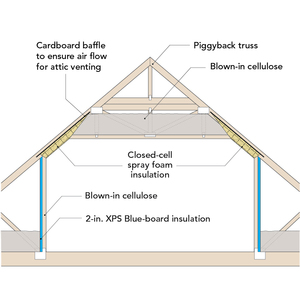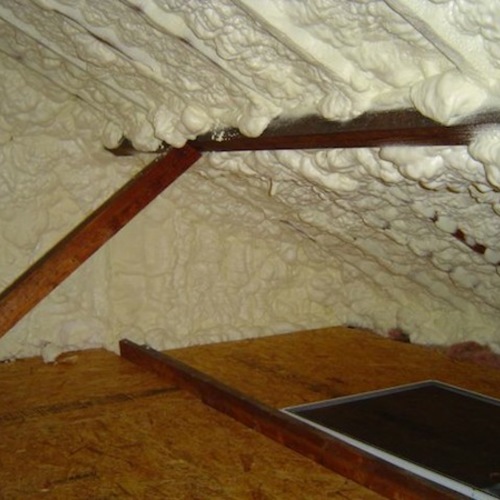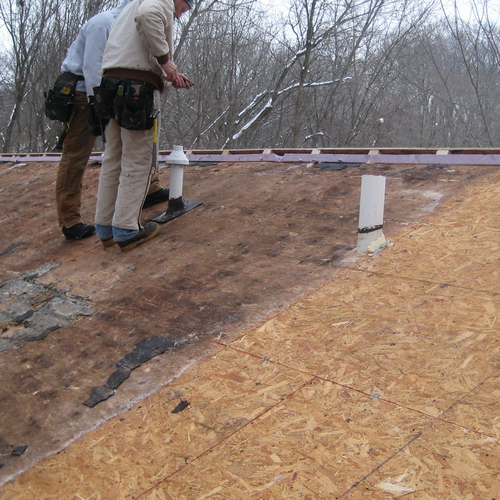
Ten years ago, Georgia led the United States in adopting a new energy code. Perhaps the biggest advance was that it required all new homes to meet a threshold for airtightness (7 ACH50). Now most states require blower-door tests and the threshold is generally in the 3 to 5 ACH50 range. Unfortunately, Georgia has fallen behind. It took us seven years to update the energy code. When we did, we increased the airtightness requirement, but not as much as the International Energy Conservation Code (IECC), and we opted out of better insulated walls. Yes, we still allow R-13 2×4 walls in new homes.
We did improve the attic insulation, though. The new state energy code requires R-38 attic insulation statewide. Further, because the code also requires better windows, home builders can’t get homes to meet the code with R-20 spray foam insulation on the roof deck without demonstrating compliance through what’s called the performance path (section 405 in the IECC). They had been getting this lower level of attic insulation approved with a simpler method called the total UA alternative. In other words, they could get a lower insulation level for the attic to comply by using better-than-code windows, which builders were doing already anyway.
Georgia’s R-20 spray foam amendment
Fast-forward a couple of years, and now builders want to go back to the simpler days of getting R-20 spray foam−insulated rooflines to pass automatically. To do so, they’ve got an amendment up for adoption that would automatically allow R-20 impermeable insulation (i.e., spray foam) if they meet three other stipulations:
- Increase airtightness from <5 ACH50 to <3 ACH50
- Install whole-house mechanical ventilation that’s not exhaust-only
- Cover the rafters with a minimum of R-3 insulation
This amendment would make it a prescriptive requirement to put R-20 spray foam insulation on the underside of the roof deck. That’s the easiest way to pass code. Check the four boxes (the three above plus R-20) and you pass.
Does spray foam equate to high performance?
In talking about the amendment with supporters, I heard people say that encapsulating an attic with R-20 spray foam makes it a high-performance home. Fifteen years ago, I would have agreed with that statement. Now, not so much.
Does spray foam in the attic make the house more airtight? Maybe. Does spray foam in the attic lower the heating and cooling load of ducts in the attic? Probably. Is R-20 enough? No.
We’ve done some modeling on what it takes to get R-20 spray foam−encapsulated attics to pass the current code, and they just barely make it . . . sometimes. Here’s what I wrote about that in my letter opposing the amendment:
The performance path in the energy code, section 405, may allow some homes to pass, but based on our examination of this method, it’s very close. We modeled two house plans of a local builder. One passed, and one failed at 2.99 ACH50. The one that passed came in at 0.3% less than the required threshold. (The floor plans modeled are 3,200 sf with R-20 insulated roofline, 14.5 SEER air conditioner, 96.1 AFUE furnace, and ducts in the attic.) Those same house plans with an air leakage rate of 4.99 ACH50 miss the threshold by more than 10%.
If R-20 spray foam attics are that close to the line of barely legal—uh, I mean, code minimum—you’ve gotta really stretch to call that a high-performance home. Yeah, they’ll have a bit more airtightness, get mechanical ventilation, and have some insulation in the rafters. They’d be doing the first two of those things anyway if Georgia hadn’t weakened the IECC requirements in those areas.
But come on. High performance? No way!
Spray foam isn’t a miracle product
I like spray foam insulation. I have it in my house. My attic is encapsulated with open-cell spray foam. My crawlspace is encapsulated with closed-cell spray foam on the band joists. When it’s done properly, it definitely helps with airtightness and makes it easy to reduce the loads on ducts in attics.
Not all spray foam is done well, however. We get a lot of calls from people who had spray foam insulation installed in their attics and have problems with odors, humidity, or heat. The most popular article I’ve written here in the Energy Vanguard Blog is 4 Pitfalls of Spray Foam Insulation. It’s been viewed 14,000 times this year already, and millions of times since I wrote it in 2010. If people weren’t having trouble with spray foam insulation, this article wouldn’t be so popular.

Take my house, for example. My wife and I bought it from my father-in-law two years ago. He’d had the attic encapsulated with open-cell spray foam insulation in 2012. A couple of years later, he had to hire another contractor to deal with the moisture and mold problem that resulted from the very bad spray foam job. When we moved in, I had a lot more spray foam installed to bring the attic up to R-40+, and it reduced the air leakage of the house by 22%. (Stay tuned for articles on the before and after conditions.*)
Spray foam insulation isn’t a miracle product. In fact, it often suffers the same problem for which spray foam contractors bash fiberglass: poor installation. Worse, bad spray foam installers can create more serious problems for homeowners than bad fiberglass installers.
Is R-20 in the attic ever enough?
When it comes to new homes, my answer is no for almost everyone. My one exception would be homes in mild climates that need little heating or air conditioning. I’m thinking of places like Santa Monica, California, but even then, I’d have to look at the data.
Where an R-20 encapsulated attic does sometimes make sense is for existing homes. If a homeowner has a set budget for improvements, using some of that to do R-20 spray foam on the roofline can provide a lot of benefit if ducts are in the attic and if it reduces air leakage significantly. I was a home performance contractor from 2004 to 2007, and that was one of the things we did.
But no house with an R-20 attic should ever be called a high-performance home. You’ve got to be at R-40 minimum just to be in that conversation; R-20 should be the minimum for walls. (I need a cartoon here based on the old Trix cereal commercial, except the slogan would be: “Silly rabbit, R-20 is for walls!”)
The case against an R-20 attic also includes what we learned from Texas this winter. A home with only R-20 will become unlivable much faster in the case of a power outage than would a house with a fully insulated attic. With more and stronger effects of climate change showing up every year, we should be requiring new homes to be more resilient, not less.
The sum and substance of this issue is that spray foam insulation was allowed to have a lower R-value 20 years ago because of two things: It made a significant difference in airtightness and it could bring ducts inside the building enclosure. Now, all new homes have to be airtight (well, OK, not in Mississippi), so spray foam insulation shouldn’t get this pass anymore.
_________________________________________________________________________
Allison Bailes of Atlanta, Georgia, is a speaker, writer, building science consultant, and founder of Energy Vanguard. He is also the author of the Energy Vanguard Blog and is writing a book. You can follow him on Twitter at @EnergyVanguard.
* We had the additional open-cell spray foam installed by Woodman Insulation using SES open-cell spray polyurethane foam, and they did a great job. In full disclosure, they did provide this to me at no cost.
Weekly Newsletter
Get building science and energy efficiency advice, plus special offers, in your inbox.















12 Comments
The 2012-2018 International Energy Residential Code, IRC, requires minimum insulation in the attics, R38 in Climate Zones 2-3 and R49 in Climate Zones 4-8, and the 2021 International Energy Residential Code, IECC, requires minimum insulation in the attics, R49 in Climate Zones 2-3 and R60 in Climate Zones 4-8 for a reason. These R values are based on science and energy efficiency.
Does anyone thinks the laws of physics cares what code is applied? The Performance and AU codes are being used to cheat. Foam insulation companies convince Builders that this is OK, even if the Performance and AU codes are not applied. I call it fraud. It’s time for ICC to stop this practice… but then again, the NAHB mafia is imbedded in the ICC decision process nowadays.
https://www.finehomebuilding.com/2019/11/06/critics-claim-agreement-helps-home-building-industry-block-tougher-energy-codes
https://www.huffpost.com/entry/building-codes_n_603d0f3bc5b6d7794ae0e15f
https://www.greenbuildermedia.com/blog/biden-administration-looks-into-icc-nahb-voting-proposal
https://www.greenbuildermedia.com/blog/iccs-response-to-congress-including-secretive-nahb-mou
https://www.greenbuildermedia.com/hubfs/CodeWatcher/Code-Council-Response-to-Jan-19-2021-EC-Ltr-.pdf
https://neep.org/blog/2021-iecc-last-energy-code
NAHB has a great educational program for its members, unfortunately is not mandatory and few members participate. Anyone who teaches or ever taught the NAHB Green Building classes, including me, can demonstrate that following those teachings can make a house more affordable to build and operate. In addition, if you include a potentially higher appraised value following the Appraisal Institute’s Green Addendum, and if lenders would offer available Energy Efficient Mortgages, that would make it a great combination and a more affordable option. Apparently, many at NAHB do not agree with their own education program and the Economists do not agree with that either, or that was not a part of their research.
Per NAHB in February, “The 2021 US estimates indicate that a $1,000 increase in the median new home price ($346,757) would price 153,967 households out of the market.” So, I guess it’s OK for US homeowners to pay higher energy bills and continue getting screwed in the long run.
Especially with some European countries MANDATING PASSIVHAUS PERFORMANCE for new builds, its pretty sad that here in the USA we continue to build mostly substandard quality building shells that require more energy for heating and AC. AND as this article points out, less resilient homes when the power goes out.
I wish that we also would avoid spray foam, or use qualifiers when we discuss spray foam, as it seems to be encouraging people to use older versions of products with higher global warming potential. Might be a high performance home from an energy perspective, but not a "green" building.
I'm in favor of more holistic approaches. Allow builders the freedom to get equally low total environmental impact at a lower cost. And look beyond residential buildings and make sure that the $/damage avoided isn't out of line with alternative ways to spend the same $. Think "you can build whatever you want, but we are going to tax you on excessive environmental damage and this money will be efficiently spent elsewhere, achieving even less environmental damage".
If you are using expensive spray foam in the roof and something cheaper in the walls, a R40 roof and R20 walls can be quite illogical. Spend some time with BEopt before using "silly".
I agree 100% with you, Jon, as long the Designers, Builders and subs in the industry are educated enough to make good decisions for their clients. Unfortunately that is not a reality in most of the US, and that's why the Code Industry is there, so lets make it the best it can.
And another article that shows why we need to move to a set of national building codes (vs state-by-state or township/borough) where all safety requirements are applied everywhere equally and all energy savings requirements are applied equally by climate zone.
It's been a while since I have been on this site so pardon my surprise when I see that it has been taken over by Nazis. Since when do a handful of self-described "building scientists" have the right to tell everyone else how to build a home? Not one of you has mentioned even the possibility that some responsible builder somewhere might actually build a better home, beat out his/her competition, and gain significant market share by offering the public a better product. You simply want to bash builders, bash the NAHB, and act as if you have the right to tell everyone how they MUST build a home.
What ever happened to choice in the marketplace? What ever happened to open and free competition? What ever happened to "Build a better mousetrap and people will beat a path to your door"? What ever happened to passionate industry professionals who are willing to make their case by actually building better homes?
Barry,
If you want to be taken seriously and be part of a reasoned discussion, try not labelling people with differing opinions Nazis. It both weakens your case and disrespects their victims.
OUCH! Barry, I’m sorry you started your argument by calling me, and others, Nazi. I think you lose any argument the moment you start insulting people with different opinions.
I remember when you started educating yourself in high-performing buildings a dozen or so years ago, and as a custom Builder you probably offer better building practices than most, but the reality I see throughout the US, is that most Builders do not build good houses, and just a small percentage build high-performing.
I do praise NAHB for their Education program, but you know as well as I do that a very small percentage of members get designations, and much less follow their own ICC-700. In about 15 years, they have about 250,000 NGBS Green certifications. I’ll challenge you to get some new stats. If NAHB with about 150,000 members who build about half of the 1.5MM US residential units per year, that’s somewhere 10MM houses in 15 years, so it’s around 2.5% per year. I don’t know what that figure is nowadays, but it does not speak highly of their own program. I work with Builders 10 miles away from the DFW metroplace, rural TX and other states who build without codes, and the quality of construction is awful. Building Codes is what makes most Builders do a better job. FYI, one of those Builders I speak off, was a DBA President a few years ago.
Apparently, I’m not the only Nazi within the industry. From one of my links: “The ICC made the code development process change despite hundreds of individuals and organizations, 30 states, and 60 cities and towns directly submitting comments and testifying at a hearing regarding the code development methodology change - the majority, over 75 percent, expressed their opposition. The National League of Cities, U.S. Council of Mayors, National Association of State Energy Officials, and Urban Sustainability Director's Network all voiced opposition on behalf of the thousands of cities, states, and local governments that they represent. Additionally, the American Institute of Architects, ACEEE, ASHRAE, NRDC, and others expressed opposition to the ANSI code development process change.” Northeast Energy Efficiency Partnerships.
I’m sure you and your family feel safe in your vehicles knowing the NTSB and NHTSA protect you, also when you fly while the FAA is watches over you. So who is really watching over the housing industry?
I agree that using the label "Nazi" automatically invalidates the rest of your argument. I'm guessing you're feeling defensive because you use spray foam. Don't you tell your clients how they should build, using your experience and values? Or do you let them have whatever they want, because "free market?"
Everything on GBA is a conversation, and nobody is telling anyone what they HAVE to do. We do explain why certain approaches--such as unabashed use of spray foam--may not be the smartest choice. Others will argue why it is a good choice, and if we are open-minded, we all learn something.
There is more to life and building than economics. Perhaps you have a constructive comment to add to this conversation?
Check this out: https://www.youtube.com/watch?v=zhkGcklWB_Q&t=12s
Mat Reisinger interviews Joe Lstiburek on moisture accumulation on the underside of roof decking, accumulation and rot at ridge.
Lstiburek published a paper on this in 2017.
Reisinger shows his solution.
Building Science Corporation:
BSI-016: Ping Pong Water and The Chemical Engineer
Joseph Lstiburek
OCTOBER 15, 2016
I have R20 of closed cell foam in my attic ceiling up here in zone 6., which forms ventilation chute, works quite well with 16 inches of fiberglass on the attic floor. The temperature sensor shows a drop from 130f down to 104f. This means less heat gain for the AC. In the garage, I used reflective rigid foam to create a ventilation chute and sealed with tape, similar results but at a fraction of the cost. Maybe that contractor above forgot to come back and insulate the floor.
The GBA site is great because it does describe alternative methods and approaches. The next house will be use less CCF with natural polymers and more air sealing.
Hopefully, one of the editors her at GBA will post an article on Natural Polymers LLC here at GBA, for a good discussion on the engineering. Remember, that Engineering is the application of science to solve a problem such as heat loss.
Log in or create an account to post a comment.
Sign up Log in